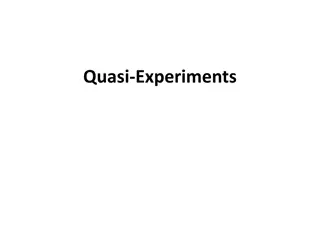Understanding Multiple Baseline Designs in Behavioral Experiments
Multiple Baseline Designs are a type of experimental design used in behavioral research. This design involves measuring two or more behaviors concurrently in a baseline condition, applying a treatment variable to one behavior at a time while maintaining baseline conditions for others, and then sequentially applying the treatment to other behaviors. The design helps demonstrate experimental control by observing similar changes in behaviors only when the treatment variable is introduced. It is a valuable tool for studying behavior change in different contexts and settings.
- Behavioral Research
- Experimental Design
- Multiple Baseline Designs
- Behavior Change
- Treatment Variable
Download Presentation

Please find below an Image/Link to download the presentation.
The content on the website is provided AS IS for your information and personal use only. It may not be sold, licensed, or shared on other websites without obtaining consent from the author. Download presentation by click this link. If you encounter any issues during the download, it is possible that the publisher has removed the file from their server.
E N D
Presentation Transcript
UNIT 6: Multiple Baseline & Multiple Probe Designs
2 AGENDA MULTIPLE BASELINE DESIGNS MULTIPLE PROBE DESIGNS UNIT 9 PROJECT AGENDA
3 EARLY POSTERS: EARLY POSTERS: Kevin Kayla Neil Jessie Bettina Lury Julie
MULTIPLE BASELINE DESIGNS Across Participants Across Settings Across Behaviors
WHAT IS A MULTIPLE BASELINE DESIGN? An experimental design that begins with the concurrent measurement of two or more behaviors in a baseline condition, followed by the application of the treatment variable to one of the behaviors while baseline conditions remain in effect for the other behavior(s). After maximum change has been noted in the first behavior, the treatment variable is applied in sequential fashion to each of the other behaviors in the design. Experimental control is demonstrated if each behavior shows similar changes, when and only when, the treatment variable is introduced. (Cooper, Heron & Heward 2007)
Target behavior is SIB Begins with the concurrent measurement of two or more behaviors in a baseline condition Alice Betty Carol
Followed by the application of the treatment variable to one of the behaviors while baseline conditions remain in effect for the other behavior(s) Alice Who should we start with? Betty Carol
What has happened to Alice s SIB? B Followed by the application of the treatment variable to one of the behaviors while baseline conditions remain in effect for the other behavior(s) A Alice What about Betty and Carol? A Betty A Carol
B After maximum change has been noted in the first behavior, the treatment variable is applied in sequential fashion to each of the other behaviors in the design Who s Next? A Alice A Betty A Carol
B After maximum change has been noted in the first behavior, the treatment variable is applied in sequential fashion to each of the other behaviors in the design What has happened to Betty s SIB? Alice A Betty What about Carol s? A B Now what? A Carol
B A Alice Do it again! It s Carol s turn! Betty Carol
Internal Validity Demonstrated by immediate change in DV upon introduction of the IV Delay in effect weakens internal validity Inconsistent effects across participants weakens internal validity
Alice Is this just as good? Betty Carol
B Mom s House A Multiple Baseline Across Settings Dad s House School
Internal Validity Need to collect acceptable BL data in each setting Behavioral covariation target bx will function independently across stimulus conditions. Inconsistent effects stimulus control must be similar to permit replication each time IV is applied
DRO B Aggression A Multiple Baseline Across Behaviors Property Destruction SIBB
Internal Validity Measure independent Bx s under same environmental conditions until stability is established Data path of Bx for intervention must be stable (zero-celerating) or contra-therapeutic Systematic, sequential application of IV builds internal validity
The Nuts and Bolts of MB Designs Identify Determine Monitor Introduce Identify 3 or more tiers (behaviors, people or settings) that are functionally independent but functionally similar Determine a criterion for staggering the IV Continuously monitor all tiers Introduce IV to one tier at a time
The Good, The Bad, and The Ugly ADVANTAGES DISADVANTAGES Requires the identification and measurement of several tiers May be time consuming Prolonged baselines may be unethical Intervention does not have to be withdrawn Works for irreversible behaviors Allows for intrasubject replication
Multiple Probe Design A variation of the multiple baseline design that features intermittent measures, or probes, during baseline It is used to evaluate the effects of instruction on skill sequences in which it is unlikely that the person can improve on later steps in the sequence before learning prior steps
Multiple Probe Design Key Features 1 2 3 An initial probe is taken to determine level of performance on each behavior in the sequence. A series of baseline measures is obtained on each step prior to training on that step After criterion-level performance is reached on any training step, a probe of each step in the sequence is obtained to determine whether performance changes have occurred.
Multiple Probe Design - Example
Non-Concurrent (Delayed) Multiple Baseline Design A group of AB designs with varying (usually predetermined) amounts of time spent in the A (Baseline) Condition Baselines are not measured at the same time It allows the use of fewer resources and the researcher may extend the study to new behaviors, settings, and individuals. Allows for more flexibility.
Non-Concurrent Multiple Baseline Design - Example Year 1 - Collect BL only in Setting 1; implement IV following stable baseline Year 2 - Collect BL only in Setting 2; implement IV following stability and longer BL than Setting 1 as determined or stable). Year 3 - Collect BL only in Setting 3; implement IV following stability and longer BL than Setting 2
Example graph from Gast, Lloyd, & Ledford (2018) 2015 2016 School Year Baseline length varies 2016 2017 School Year 2017 2018 School Year
27 UNIT 9 PROJECT UNIT 9 PROJECT
Introduction Introduction 1 paragraph on general topic (the target behavior, the intervention) Literature review of at least 3 research articles 2 paragraphs each to include Rationale for your study Thesis statement A brief description of the research question(s) and hypothesis The method, setting, and subjects, research design A summary of the results The conclusions as reported by the study author(s)
General Topic General discussion of the target behavior and intervention you will study. Avoidant/restrictive food intake disorder (ARFID), a relatively new feeding disorder diagnosis in the Diagnostic and Statistical Manual of Mental Disorders, 5th ed. (DSM-5; American Psychiatric Association 2013), is provided to patients who struggle with impaired and distressing eating behaviors and symptoms yet lack the weight and body image-related concerns associated with anorexia nervosa and bulimia nervosa. Among patients with ARFID, the consumption of foods is limited based on the food s appearance, smell, brand, presentation, previous negative experiences with the food, and/or fear of choking or vomiting. Children with ARFID can have different etiologies, including but not limited to delayed oral-motor skills, failure to master self-feeding skills, history of selective (picky) eating, disruptive mealtime behavior, rigid food preferences, and/or fear of vomiting (Fisher et al. 2014; Norris et al. 2014). ARFID is directly linked to a variety of short- and long-term health consequences including growth retardation, malnutrition, developmental and psychological deficits, poor academic achievement, social difficulties, invasive medical procedures (e.g., placement of a feeding tube), or death (Kodak & Piazza 2008; Sharp et al. 2010). General Topic
General Topic ARFID Treatment Patients with ARFID have varied presentations, histories, and risk factors, making referrals to the most appropriate healthcare professionals or facilities challenging. Depending on which factors are thought to be driving the eating disturbances, patients needs differ. Few hospitals or healthcare facilities have specialized clinics to treat ARFID; thus, assessment and treatment often requires collaboration among numerous healthcare providers in various locations. Empirically validated treatments for ARFID have not yet been established (Norris et al. 2016); however, behavioral interventions have well-documented empirical support and a strong evidence base in the scientific literature for the treatment of pediatric feeding disorders (Sharp et al. 2010). For instance, operant procedures, including physical guidance of appropriate feeding responses, differential reinforcement (DRA) contingent upon appropriate eating behaviors, and shaping, have been identified as effective interventions (Hodges et al. 2017), and several studies have demonstrated the effectiveness of a systematic hierarchical sequence using differential reinforcement contingent upon demonstrating desired behaviors to increase food acceptability (Hodges et al. 2017). In the case of feeding interventions, the desired behavior is typically amount/bites/volume consumed, increased variety of foods, and/or appropriate mealtime behavior. General Topic
Literature Review Feeding treatment often involves numerous office visits. Even to complete the initial intake, several appointments with the dietitian, speech therapist, psychologist, and/or additional feeding clinic member(s) may be required. Although children typically eat in the home setting, feeding assessment and treatment typically occurs in behavioral health clinics and specialty inpatient programs (Milnes & Piazza, 2014) and rarely in the home (Najdowski et al. 2003). To improve generalization to the home environment, telehealth is a desirable mode of delivery for feeding assessment and therapy to allow for naturalistic observations within the home environment, including parent-child interactions that may contribute to feeding problems (Silverman 2010). Telehealth is defined as the delivery of virtual health-related services from one site to another via information and communication technologies (e.g., video, remote patient monitoring, or mHealth mobile applications). Telehealth is a modality of treatment rather than a specific type of treatment. Guidelines for telehealth treatment delivery exist in the USA and Canada (e.g., APA 2013; American Telemedicine Association 2013; Consortium of Telehealth Resource Centers 2015). Literature Review Problem Proposed solution
Literature Review In regard to feeding treatment, teleconsultation has been considered probably useful for the initial clinical interview and likely to be useful for behavioral management and parent training sessions (Silverman 2010). Positive outcomes have been demonstrated with the use of videoconferencing to deliver treatment for children and adolescents with chronic illnesses (Van Allen et al. 2011) and depression (Nelson et al. 2006). Additionally, an 8-week parenting intervention using teleconsultation for families of children with ADHD improved children s behavior while decreasing parental distress (Reese et al. 2012). Parents of children who participate in interventions via teleconsultation generally report high levels of treatment satisfaction (Hall & Bierman 2015). While a recent investigation of a family-based treatment for anorexia nervosa delivered via telehealth indicates satisfactory clinical outcomes (Anderson et al. 2017), no known investigations exist on the use of teleconsultationto deliver feeding treatment to children with ARFID. Literature Review Relevant studies
Rationale and Thesis Statement This study aimed to contribute to the research on parent teleconsultation telehealth applications of parent- implemented behavioral strategies by implementing a stepwise changing contingency for reinforcement procedure for a child with ARFID. The treatment presented in this study was developed to address treatment needs for children with ARFID and extends the work of Fisher et al. (2014). Research questions and hypotheses were as follows: Rationale and Thesis Statement Is there a functional relationship between an intervention identified by parent teleconsultation (i.e., a stepwise changing contingency for reinforcement) and the increase in the level of bites of nonpreferred foods consumed? To what extent can a parent implement a behavioral feeding intervention taught over teleconsultation with high treatment integrity as measured by 80% or greater fidelity on a treatment integrity checklist? It is hypothesized that a parent will complete intervention procedures with high levels of treatment integrity.
Reference Reference Bloomfield, B. S., Fischer, A. J., Clark, R. R., & Dove, M. B. (2019). Treatment of Food Selectivity in a Child with Avoidant/Restrictive Food Intake Disorder Through Parent Teleconsultation, Behavior Analysis in Practice (12) 33 43.























